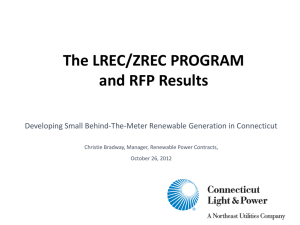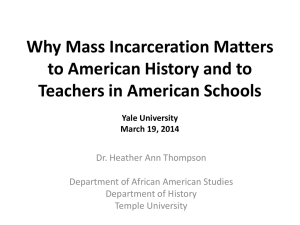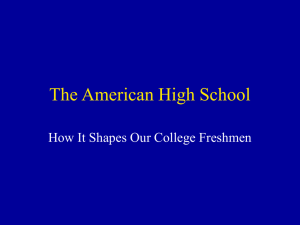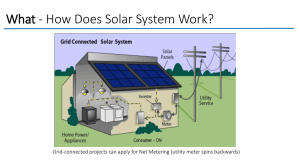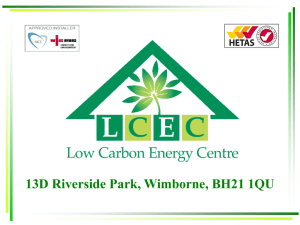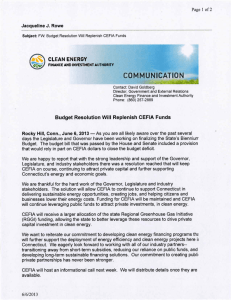Kragie-DEEP-FarmEnergy
advertisement
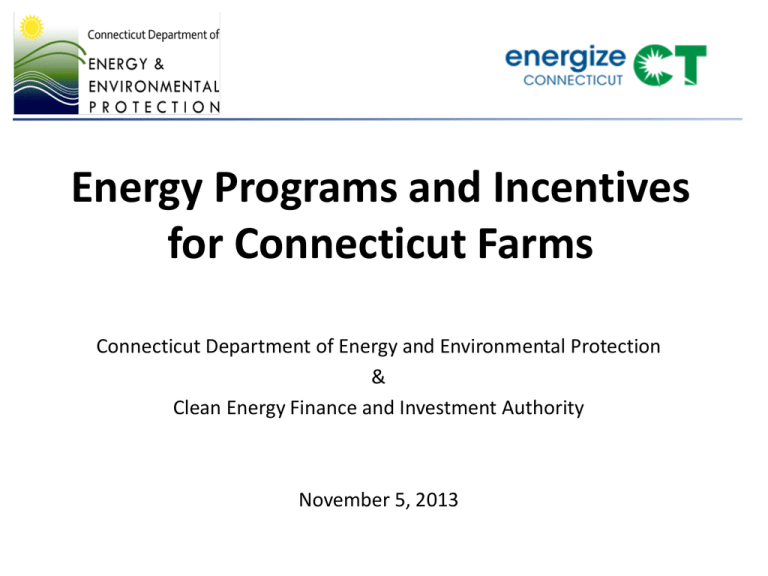
Energy Programs and Incentives for Connecticut Farms Connecticut Department of Energy and Environmental Protection & Clean Energy Finance and Investment Authority November 5, 2013 Connecticut’s Energy Strategy Cleaner energy Cheaper energy More reliable energy Presentation Overview Cleaner, cheaper, and more reliable energy for Connecticut’s farms: • Choose Your Electric Supplier • The Comprehensive Energy Strategy and Opportunities for Natural Gas Connections • Reliability and Renewable Energy Programs – Virtual Net Metering – Microgrid Program – Anaerobic Digestion – Combined Heat and Power – LREC/ZREC Program – C-PACE Choose Your Electric Supplier • You may be able to save money by selecting a different electric supplier • Your electric bill is divided into two parts: Delivery and Generation • Delivery services are provided exclusively by CL&P and UI and are not subject to competition • Generation services are available from your electric company, referred to as Standard Service, as well as from third party electric suppliers • www.EnergizeCT.com includes a resource that allows customers to compare available generation plans and rates Choose Your Electric Supplier • For most customers, CL&P and UI bill on behalf of third party electric suppliers • This means that you will continue to receive one electric bill even if you select one of the alternate suppliers • Some suppliers enroll customers through promotional offers which move to a variable rate plan • Some fixed rate plans also move customers to a variable rate when the fixed period ends • The Department has seen variable rates fluctuate dramatically We encourage customers to regularly check your generation rate and to visit www.EnergizeCT.com/suppliers to see if you can lower your electric costs. Comprehensive Energy Strategy Gas Expansion Plan for Connecticut • Comprehensive Energy Strategy provides a systematic basis for addressing the state’s energy challenges and opportunities • Provides a foundation for better energy choices at the household and business level, focusing on cleaner, cheaper, more reliable • Includes a plan for expanding the availability of natural gas in Connecticut – – – – – – – – Making gas available to 280,000 new customers over 10 years Increasing gas pipeline capacity into Connecticut Making conversion to natural gas affordable through rebates and incentives Assuring that rate impacts on existing customers are minimal Integrating gas conversions with energy efficiency measures Reducing emissions and greenhouse gasses Creating jobs and economic growth Reducing heating costs for ratepayers Contact Info for Gas Distribution Companies in Connecticut Connecticut Natural Gas: www.cngcorp.com 860-727-3000 Greenwich Office: 888-264-2677 Southern Connecticut Gas: http://www.soconngas.com/ 800-659-8299 Yankee Gas: http://www.yankeegas.com/ 800-989-0900 Virtual Net Metering Overview • Policy is meant to encourage the installation of distributed generation by providing a financial incentive to do so. • Allows customers (Customer Host) to assign surplus production to other metered accounts (Beneficial Accounts), that are not physically connected to the Customer Host’s generator. • Must generate electricity from either Class I (solar, wind, fuel cell, geothermal, landfill gas, anaerobic digestion, hydro, etc.) or Class III (energy efficiency, combined heat and power) resources, from facilities up to 3 MW. • Production from the generator is first used to reduce the electric bill of the Customer Host. • Surplus production is then assigned (virtually) to reduce the monthly electric bill of one or more designated Beneficial Accounts. Virtual Net Metering Applying Credits • An Agricultural Customer Host can assign up to ten Beneficial Accounts. • Surplus production (aka Virtual Net Metering Credit) is assigned to the monthly bill of each Beneficial Account and will appear as a credit. • If the Customer Host produces more electricity than the Host and the Beneficial Accounts together use in a billing period the excess (aka Unassigned Virtual Net Metering Credit) is ‘banked’ and can be applied to a future electric bill. • Any Unassigned Credits that remain ‘banked’ at the end of the calendar year are credited to the Customer Host. Virtual Net Metering Value of Credits • Customer Host production reduces the amount purchased from the utility. • As a result, the value of each kWh produced equals the total kWh price for delivery and energy, (the full retail price) the Customer Host would otherwise pay to purchase each kWh. • Virtual Net Metering Credits applied to Beneficial Accounts will offset the full kwh energy charge and a portion of the kWh Transmission and Distribution charges. • Unassigned Credits that remain at the end of the calendar year are credited to the Customer Host at CL&P or UI’s Standard Service Generation rate and a percentage of the kWh Transmission and Distribution charges. Virtual Net Metering Process and Contact Info • CL&P and UI are working to finalize the administrative process for this policy. • For update, visit www.EnergizeCT.com/virtual • For more info, contact: Art Marcelynas, Dept of Energy and Environmental Protection 860-827-2887 Arthur.Marcelynas@ct.gov Microgrids • Microgrids will provide critical services to residents • Generate electricity with cleaner, 24/7 operational power sources – Natural gas turbines with combined heat and power, fuel cells, solar panels, etc. • Engineered to “island” from the grid when the larger grid is de-energized • Built in a cost-effective manner • Connects more than one critical facility to reliable distributed generation resources • Bond funding to help with design, engineering, and interconnection infrastructure costs What is a critical facility? • • • • • • • • • • • • • • Hospital Police station Fire station Water treatment plant Sewage treatment plant Agricultural facilities Public shelter Correctional facility Municipal center Telecommunications equipment Gas station Pharmacy Grocery Store Etc. Microgrids: Round Two Notice of Round Two Microgrids Program Schedule and Outline October 28, 2013 Comments Due on Round Two Microgrids Program Schedule December 3, 2013 Program Information Release (FAQ) December 2013 Issue Round Two Request for Proposal (RFP) January 2014 Round Two RFP Bidder’s Conference February 2014 Round Two RFP Submission Response Date June 2014 Announce Selection of Non-municipal and Municipal September 2014 Awards Contact Info for Microgrid Program Alex Kragie Deputy Chief of Staff Connecticut Department of Energy and Environmental Protection 860-424-3000 alex.kragie@ct.gov Veronica Szczerkowski Connecticut Department of Energy and Environmental Protection 860-827-2890 veronica.szczerkowski@ct.gov Anaerobic Digestion Program • $6M Pilot Program: launched by CEFIA in March 2012 Funded to $2M/year for 3-years (program closes Feb. 2015) Open to new projects that have not yet started construction Up to $450/kW (incentive in the form of a grant, loan or PPA) Maximum project size 3 MW Projects requesting loans or PPAs have a higher probability of being selected for program Projects that process food waste, in support of CT’s new recycling legislation, get greater consideration Program can fund up to 5 total projects Combined Heat & Power Program • $6M Pilot Program ($5M remaining): Launched by CEFIA in March 2012 Funded to $2M/year for 3-years (program closes Feb. 2015) Open to new projects that have not yet started construction Up to $450/kW (incentive in the form of a grant, loan or PPA) Maximum project size 5 MW Projects requesting loans or PPAs have a higher probability of being selected for program Program can fund up to 50 MW of projects Contact Info for Anaerobic Digestion and Combined Heat and Power Rick M. Ross Senior Manager, Clean Energy Deployment Clean Energy Finance and Investment Authority rick.ross@ctcleanenergy.com 860-257-2887 LREC/ZREC Program • Developed to promote and expand renewable generation • Creates a market-driven process for small renewable energy producers to obtain 15-year revenue stream from the sale of RECs to electric utilities • REC = the “renewable” attribute of a renewable generation source • LREC: Low – emission RECs = e.g., Fuel Cells • ZREC: Zero – emission RECs = e.g., Solar, Wind, Small Hydro • Each megawatt hour of energy produced = 1 REC 19 Eligibility Criteria for LREC/ZREC Energy Sources • Must be eligible to qualify as Class I renewable energy project • Must be located behind contracting utility distribution meter • Must not have received funding/grants from Clean Energy Finance Investment Authority, or its predecessor the CT Clean Energy Fund (other than low cost financing) • Projects must be in service on, or after, July 1, 2011 • Must certify site control • LRECs – No larger than 2,000 kW – Must have low emissions – May include fuel cells and other low emission Class I resources, as well as all zero emission Class I resources • ZRECs – No larger than 1,000 kW – Must have zero emissions – May include solar, hydro and wind 20 LREC/ZREC Future Opportunities • Utilities expect to offer the Year 2 Small ZREC in first quarter of 2014 • Utilities expect to offer the Year 3 RFP for LRECs and ZRECs in April 2014 • If you are interested in connecting with a renewable energy project developer, visit: http://www.energizect.com/residents/find-aprofessional?query=1&servicetype=Solar+PV&company=&zip= 21 Contact Info for LREC/ZREC Christie Bradway, Northeast Utilities christie.bradway@nu.com 860-665-5296 Gary Zielanski, United Illuminating gary.zielanski@uinet.com 203-499-3982 22 Commercial Property Assessed Clean Energy (C-PACE) • An innovative financing structure that enables commercial, industrial, and multi-family property owners to access financing for qualified energy upgrades and repay through a benefit assessment on their property tax Private capital provides 100% upfront, low-cost, long-term funding Repayment through property taxes A senior PACE lien is put on the property and stays regardless of ownership C-PACE Case Study: Solar at Rural Hardware Store Project • 72 kw solar rooftop facility • Mortgage held by Farm Credit East/guaranteed by USDA Financing • $259,000 C-PACE assessment (20 yrs) • $27,000 annual energy savings (including ZREC) plus 30% ITC • $21,000 annual C-PACE assessment Impact • 274,596 kBTU/year saved • Produces 80,768 kWh/yr in clean energy Contact Info for C-PACE Genevieve Sherman Manager C-PACE Clean Energy Finance and Investment Authority 860-257-2897 genevieve.sherman@ctcleanenergy.com http://www.c-pace.com Thank you! Q & A following Amanda’s presentation
